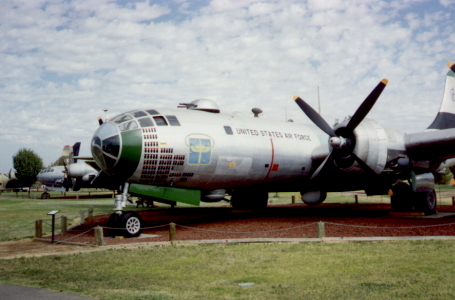- On January 2, 1962, at 11:17 a.m. a big 4 engine KB-50
ariel tanker took off from Norfolk, Virginia, with 8 crew. Her destination
was Lajes in the Azores. Major Bob Tawney was her pilot. According to orders,
he sent messages every hour.
-
- A paraphrase of his technical transmission would follow
something like this:
-
- This is Tyler 41. I am at 37o 15 minutes North Latitude,
70o West Longitude at 12:17 p.m. My flight level is 23,000 feet. I am flying
on instruments, heading 085 degrees. My ground speed is 385 mph. Endurance
is 11 + hours. My destination is Lajes. Am estimating 37o 30 minutes North
Latitude 65o West Longitude at 1 p.m. and 37o 35 North Latitude 60o West
Longitude next. I request that you relay this to New York Oceanic Air Control.
-
- At 1 p.m. Tawney or his copilot Zoltan Szaloki were
overheard by a Navy Transport plane about an hour behind them. They were
trying to raise Harmon Control, then other stations along the east coast.
Between 1:10 and 1:20 p.m. Tawney was able to contact the Navy Transport
and informed them of his position, asking them to relay it back.
-
- However, the transport was also having difficulties.
So with little else to do, Tawney finally just signed off and continued
to the Azores. They were just about north of Bermuda at this point, near
where <http://www.bermuda-triangle.org/Investigations/Pogo_22/pogo_22.html>Pogo
22 had vanished just months before, and <http://www.bermuda-triangle.org/Investigations/The_Tudors/the_tudors.html>Star
Tiger had 14 years earlier.
-
- By 7 p.m. Lajes was anxious for their arrival. When
an immediate radio search failed to reach them, a huge search was ordered
and began at 8:15 p.m.
-

-
- The KB-50 was a converted B-29 bomber into tanker. It
had an enormous range and fast speeds. This mammoth is a B-29 at Castle
AFB museum. A KB-50 is actually in the background.
-
- According to COMEASTAREA and COMUSFORAZ, the Air Force's
various command areas, one hundred and sixty-two sorties were flown in
a combined 1,369 flight hours by the US Air Force alone, with an addition
7 sorties and 49 search hours by the US Navy, and 23 sorties in 236 hours
by the US Coast Guard. In addition, there were 5 Coast Guard cutters which
search the entire flight track of the KB-50 from Langley to the Azores,
a 412 hour search covering 440, 820 square miles of the Atlantic, to date
the largest search for any lost plane or ship. The results of this massive
search were summed up in the Narrative of the accident report. Somewhat
blandly put, it reads: "No trace of any survivors or wreckage was
ever found, thus preventing the accident Board from obtaining any physical
evidence upon which to base their investigation." Case was closed.
-
- What did happen to the great plane? The Virginia
Pilot was told that the last transmission from Tawney came when he was
about 240 miles off the coast. The Coast Guard then reported that they
found an oil slick about 300 miles off the coast. Thus it seemed to everybody
that the plane crashed into the sea for no reason shortly after Tawney's
last transmission. However, the Coast Guard had no way of knowing that
Tawney had been in touch with the Navy Transport plane flying the same
route. His last known message had placed him far past the spot of the oil
slick, north of Bermuda where so many others had inexplicably vanished.
The conclusion of the report is really all that can be said. Yet when it
is added to what has been said about all the others lost here, it becomes
an undeniable pattern of mystery, all in and about the border of the Sargasso
Sea north of Bermuda that, at the very least, justifies the phenomenon
of the Bermuda Triangle.
-
- http://www.bermuda-triangle.org/Investigations/Tyler_41/tyler_41.html
|